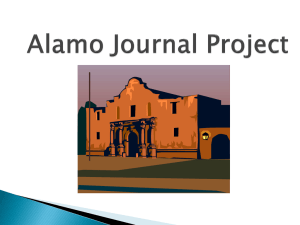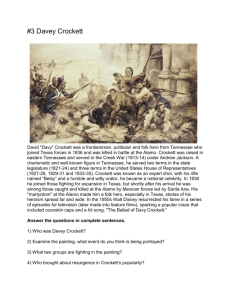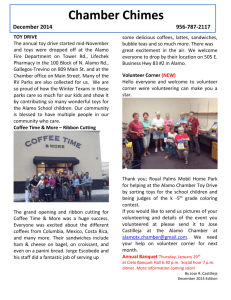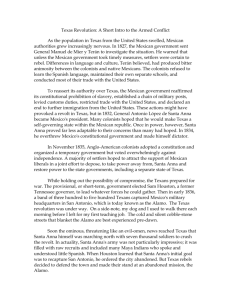Long Excerpt from the text
advertisement
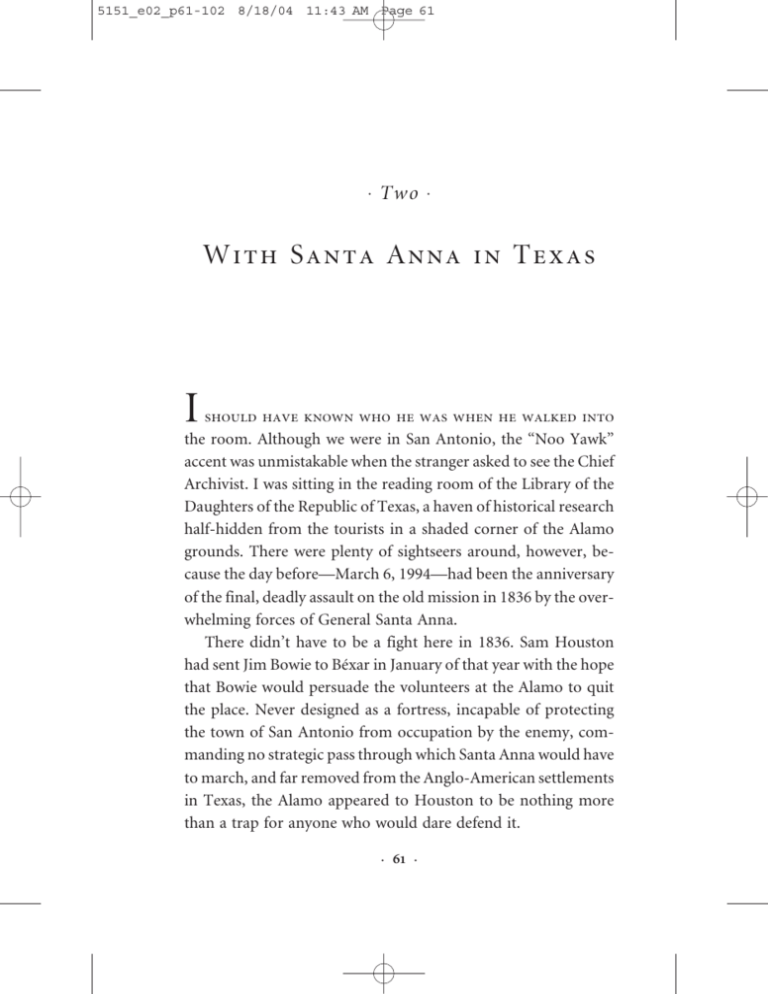
5151_e02_p61-102 8/18/04 11:43 AM Page 61 • Two • With Santa Anna in Texas I should have known who he was when he walked into the room. Although we were in San Antonio, the “Noo Yawk” accent was unmistakable when the stranger asked to see the Chief Archivist. I was sitting in the reading room of the Library of the Daughters of the Republic of Texas, a haven of historical research half-hidden from the tourists in a shaded corner of the Alamo grounds. There were plenty of sightseers around, however, because the day before—March 6, 1994—had been the anniversary of the final, deadly assault on the old mission in 1836 by the overwhelming forces of General Santa Anna. There didn’t have to be a fight here in 1836. Sam Houston had sent Jim Bowie to Béxar in January of that year with the hope that Bowie would persuade the volunteers at the Alamo to quit the place. Never designed as a fortress, incapable of protecting the town of San Antonio from occupation by the enemy, commanding no strategic pass through which Santa Anna would have to march, and far removed from the Anglo-American settlements in Texas, the Alamo appeared to Houston to be nothing more than a trap for anyone who would dare defend it. • 61 • 5151_e02_p61-102 8/18/04 11:43 AM Page 62 SLEUTHING THE ALAMO But defend it Bowie determined to do. He wrote to Governor Henry Smith on February 2 that he was ready to “die in these ditches” rather than give up the rebel outpost. Smith agreed, but could provide little support. He ordered Lieutenant Colonel William Barret Travis to raise a company to reinforce the Alamo, but only thirty men responded to the call. Travis threatened to resign his commission rather than lead such a tiny force, but in the end he complied. When he and his troopers arrived at the Alamo, they found an ungainly structure enclosing a central plaza of almost three acres, defended by barely a hundred men. At least four times that number would be needed to operate the Alamo’s big guns and to man its lengthy walls. Not even the famous Davy Crockett, who showed up on February 8 with a handful of Tennessee volunteers, could make up for the critical shortage of manpower. When Colonel James C. Neill, the officer in charge of the garrison, was compelled to depart in mid-February to attend a family stricken with illness, clashes of personality threatened to split those who remained at the Alamo. Neill attempted to hand over command to Travis, but volunteers who favored Bowie demanded the right to choose their own commander. They prevailed, and, as their new leader celebrated his election with a “roaring drunk,” Travis was again ready to walk away from this assignment. But a powerful hangover brought Bowie to his senses, and the two men finally agreed on a joint command. There was no time to lose. Reports were already coming in from Juan Seguín’s mounted Tejano scouts that the Mexican army had crossed the Río Grande. Travis discounted these sto• 62 • 5151_e02_p61-102 8/18/04 11:43 AM Page 63 With Santa Anna in Texas ries as exaggerations, but on February 23 a large force under Santa Anna himself surprised the rebels by marching into San Antonio from the west. The Texans lounging in town barely had time to grab a few provisions and fall back into the Alamo. Bowie suggested a parley with the enemy, but Travis answered the Mexicans’ demand for unconditional surrender with a cannon shot. Further disagreement between the Alamo’s commanders vanished, however, when Bowie fell deathly ill on the second day of the siege. For the next ten days, Travis watched the noose tighten around him. Juan Seguín, James Bonham, and other couriers who slipped through the Mexican lines to find reinforcements produced paltry results. The thirty-odd volunteers from Gonzales who appeared under the walls at three o’clock in the morning on the first of March were all (that we know for certain) who came to Travis’s aid—though perhaps as many as sixty more (according to Mexican body-counts) arrived in time to become unknown martyrs. Colonel James W. Fannin’s half-hearted effort to come to the rescue ended, as we have seen, in a fiasco of broken-down wagons and wandering oxen. The remarkable thing is that Santa Anna decided to assault the Alamo at all. The few men in the fort could be easily bypassed and cut off from the rest of the Texan forces. Even if Travis wanted a battle, Santa Anna did not have to take the bait. But the Mexican commander in chief wanted vengeance and glory. A spectacular victory at the very scene of General Cos’s December disgrace was the kind of news that Santa Anna wanted to send back to Mexico City, where military victories were the surest guarantee of his political survival. • 63 • 5151_e02_p61-102 8/18/04 11:43 AM Page 64 SLEUTHING THE ALAMO The actual Battle of the Alamo was almost an anticlimax. After pounding the Texans with a constant bombardment for almost two weeks, Santa Anna ordered his guns to cease firing on the night of March 5. The mass assault on the walls, which came the next day before dawn, was twice turned back by deadly Texan firepower before the sheer force of Mexican numbers overcame all resistance. The battle was over in less than an hour. Every Texan defender of the Alamo died, but because their cause was ultimately victorious, the Texan fighters passed from life into legend. Travis wrote his way into the Texan pantheon of heroes, penning phrases in his letters from the Alamo that reverberate even today: [O]ur flag still waves proudly from the walls. I shall never surrender or retreat. . . . I am determined to sustain myself as long as possible & die like a soldier who never forgets what is due his own honor & that of his country. VICTORY OR DEATH. Bowie and Bonham also achieved heroic status through the way they faced the end: Bowie exhorting the Alamo defenders even from his deathbed and Bonham galloping back into the doomed fortress on March 3 only to report that Fannin would not be bringing relief from Goliad. David Crockett rounded out what became the Alamo’s fabulous four. With the exception of President Andrew Jackson, Crockett was the most celebrated man in North America even before he rode into San Antonio: he was known as champion bearhunter, homespun humorist, and outspoken (ex-)congressman from the backwoods. Virginian John Sowers Brooks (one of • 64 • 5151_e02_p61-102 8/18/04 11:43 AM Page 65 With Santa Anna in Texas Herman Ehrenberg’s fellow-soldiers at Goliad), upon learning that Crockett was among those who repulsed an early Mexican probe of the Alamo’s defenses, wrote his mother that “Probably Davy Crockett ‘grinned them off ’”—just as Crockett had once boasted that he could grin down an angry bear. No defender survived who saw Davy Crockett die at the Alamo, and conflicting versions of his last moments were circulating within weeks of the battle. Few in my generation, who had watched Fess Parker swinging his rifle as the television screen faded to black in 1955, doubted that Crockett fell in desperate combat. But in the ensuing decades cynicism and historical revisionism had taken a toll on such certainties. That’s why I was so interested in the gentleman from New York who had come to San Antonio on the anniversary of Crockett’s death. Bill Groneman, a New York City detective, was in the Alamo city to sign copies of his new book, Defense of a Legend: Crockett and the de la Peña Diary. This was the much-anticipated work that my editor had mentioned to me the previous summer, and the latest chapter in one of the most intense historical controversies of recent times. The diary of José Enrique de la Peña, a Mexican officer who marched into Texas with Santa Anna in 1836, was notorious for a single paragraph describing an “unpleasant episode” that had allegedly occurred only a few yards from where I was sitting in the library’s quiet reading room. De la Peña claimed to be an eyewitness to the capture and execution of David Crockett in the immediate aftermath of the Battle of the Alamo. Groneman’s book, I soon learned, was an all-out assault on the de la Peña diary, not merely on its accuracy, but on its very • 65 • 5151_e02_p61-102 8/18/04 11:43 AM Page 66 SLEUTHING THE ALAMO authenticity. After I had introduced myself to him, Bill showed me the cover of his new volume and bluntly announced its central thesis: the famous “diary” was a probable forgery. It was difficult to concentrate on my own research after Groneman left the library. As soon as it closed its doors for the day at five o’clock, I hurried across the street toward the bookstore where Groneman was still signing copies of Defense of a Legend. I bought one on the spot. Thumbing through my newly autographed copy, I was impressed. Not only did Groneman claim that the de la Peña manuscript contained telltale anachronisms indicating a forgery, but he had even provided a photograph of the suspected culprit! The suave old gentleman with the charming smile and the twinkling eyes was identified as John A. Laflin, “one of the greatest forgers in American history.” From the 1940s until his death in 1970, Laflin (among other escapades) had repeatedly tried to pass himself off as the great-grandson of Jean Lafitte, the pirate who had plied the coastal waters of Texas and Louisiana, at times smuggling slaves in concert with Jim Bowie. Even more impressive was Groneman’s published photocopy of a “Certification” from the famed handwriting expert Charles Hamilton, who had devoted a whole chapter to Laflin in his 1980 book, Great Forgers and Famous Fakes. Hamilton’s signed statement was unequivocal: “I have carefully examined the document allegedly written by JOSE ENRIQUE DE LA PENA, entitled PERSONAL NARRATIVE WITH SANTA ANNA IN TEXAS, and find that it is a forgery by John Laflin, alias John Laffite.” Groneman’s book was obviously a bombshell, a major event in a war of words over Crockett’s death that had become much • 66 •
